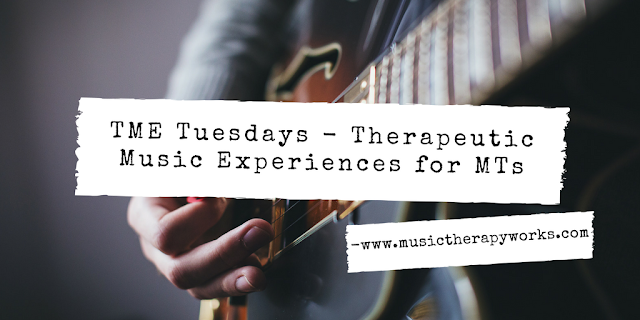TME Tuesday: Button, Button
I missed a post yesterday because my computer decided it needed to upgrade to the new version of Windows, and, after two and a half hours of waiting, it was still only at 28% downloaded. I had to go. As a result, no mindbending post from me yesterday. (It's amazing how amazing I am in my own imagination!) Today, though, the computer is upgraded, and I have a game to share.
It's not fully fleshed out into a therapeutic music experience, but it is one of my Grandmother's favorite games, and I enjoy playing it with my students. When we play it in music therapy, I add a musical stimulus or beat for entrainment purposes. Other than that, it doesn't have any music paired with it. Make up your own song to go with the game. Enjoy!
The leader, or all the children in the circle, says "Button, button, who's got the button?" and then each child in the circle guesses. The child guessing replies with their choice, e.g. "Billy has the button!"
Once the child with the button is finally guessed, that child is the one to distribute the button and start a new round.
It's not fully fleshed out into a therapeutic music experience, but it is one of my Grandmother's favorite games, and I enjoy playing it with my students. When we play it in music therapy, I add a musical stimulus or beat for entrainment purposes. Other than that, it doesn't have any music paired with it. Make up your own song to go with the game. Enjoy!
Therapeutic Experience
Button, Button
Mary Jane Landaker, MME, MT-BC
Purpose:
Social interaction; sustained attention; leadership skill development; ability
to play within game parameters; sportsmanship; fine motor coordination
Source:
Original Rules to Button, Button, Who’s
Got the Button? via Wikipedia at https://en.wikipedia.org/wiki/Button,_button,_who's_got_the_button%3F
.
Materials:
Original Rules – Small object to pass from hand to hand. NOTE: if group has
difficulty with attention to task, consider using a jingle bell or a shaker egg
that makes a subtle sound to assist with auditory tracking.
Environment:
Enough space for group members to sit in a circle.
Song/Chant/Words:
None required, but you may want to
add a song format to indicate different parts of the game (for example, a
melodic phrase for “who has the button?” and an additional phrase for “giving
the button to the next person?”).
Procedure:
Original Rules as per Wikipedia:
Button,
button, who's got the button is a game where players form a circle
with their hands out, palms together. One child, called the leader or 'it',
takes an object such as a button and goes around the circle, putting their hands in
everybody else's hands one by one. In one person's hands they drop the button,
though they continue to put their hands in the others' so that no one knows where
the button is except for the giver and receiver.The leader, or all the children in the circle, says "Button, button, who's got the button?" and then each child in the circle guesses. The child guessing replies with their choice, e.g. "Billy has the button!"
Once the child with the button is finally guessed, that child is the one to distribute the button and start a new round.
Version 2
A second similar version has the child who is "it" stand in the center of the circle. The button is then passed behind the backs of the children in the circle, stopping at random. "It" tries to guess where the button is and once the button is found takes his or her place in the circle. Whoever had the button then becomes the new "it" and play begins again.Version 3
A slight variation on the first two versions has "it" ask questions (like in the game Twenty Questions) to determine who has the button.Version 4
Another version is usually played by several children with one adult. The game's origin is unknown, but it existed before 1900. The children start by sitting on the bottom stair of a staircase. The adult holds out both fists, one holding a button. The adult asks, "Button, button, who's got the button?" Whoever guesses correctly advances one step. The first one to reach the top step wins the game. If the staircase is not wide enough, the children can be divided up into teams.
Therapeutic
Function of Music:
This is not really a music therapy
experience, even though you can still address many of the group members’ goals
using this game.


Comments
Post a Comment